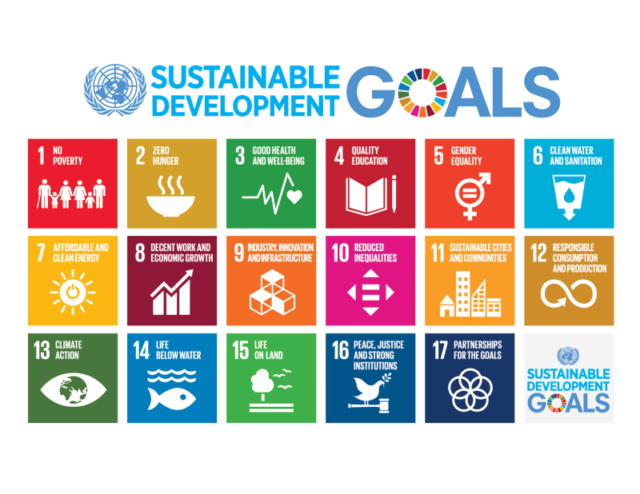PREVIOUS
Sustainable Development Goals
December 29 , 2018
2573 days
14170
0
- In 2012, the United Nations Conference on Sustainable Development (UNCSD), also known as Rio+20 or Earth Summit 2012, was held at Rio de Janeiro of Brazil as a 20-year follow up to 1992 UNCED (United Nations Conference on Environment and Development) held at the same city.
- At the Rio+20 Conference, a resolution known as "The Future We Want" was reached by member states.
- The SDGs were built on the principles agreed upon in Resolution, entitled "The Future We Want".

- On 25 September 2015, the 193 countries of the UN General Assembly adopted the 2030 Development Agenda titled "Transforming our world: the 2030 Agenda for Sustainable Development".
- Sustainable Development Goals (SDGs) are a collection of 17 global goals (169 targets) set by the United Nations General Assembly in 2015.
- The SDGs cover social and economic development issues including poverty, hunger, health, education, global warming, gender equality, water, sanitation, energy, urbanization, environment and social justice.
- With the adoption of the 2030 Agenda, the UN Member States pledged to ensure “no one will be left behind” and to “endeavour to reach the furthest behind first”.
BACKGROUND
- These 17 Goals build on the successes of the Millennium Development Goals (MDGs). For the past 15 years (2000-2015), the MDGs drove progress in several important areas.
- SDGs came into effective from January 2016.
- SDGs will continue to guide UNDP (United Nations Development Program) policy and funding until 2030.
- As the lead UN development agency, the UNDP is uniquely placed to help implement the Goals through our work in some 170 countries and territories.
Key MDG achievements
- More than 1 billion people have been lifted out of extreme poverty (since 1990).
- Child mortality dropped by more than half (since 1990).
- The number of out of school children has dropped by more than half (since 1990).
- HIV/AIDS infections fell by almost 40 percent (since 2000).
SUSTAINABLE DEVELOPMENT GOALS
- Goal 1: No poverty
- Goal 2: Zero hunger
- Goal 3: Good health and well-being for people
- Goal 4: Quality education
- Goal 5: Gender equality
- Goal 6: Clean water and sanitation
- Goal 7: Affordable and clean energy
- Goal 8: Decent work and economic growth
- Goal 9: Industry, Innovation, and Infrastructure
- Goal 10: Reducing inequalities
- Goal 11: Sustainable cities and communities
- Goal 12: Responsible consumption and production
- Goal 13: Climate action
- Goal 14: Life below water
- Goal 15: Life on land
- Goal 16: Peace, justice and strong institutions
- Goal 17: Partnerships for the goals

In INDIA
- SDG India index was released by the federal policy think tank NITI Aayog and the UN.
- NITI Aayog starts the exercise of measuring India and its State’s progress towards the SDGs for 2030, culminating in the development of the first SDG India Index - Baseline Report 2018.

- According to the SDG India Index, the nation as a whole has a score of 58, showing the country has reached a little beyond the halfway mark in meeting the sustainable development goals adopted by India and 192 other nations in 2015. The index covers 13 of the 17 sustainable development goals, including healthcare, gender equality, clean energy, infrastructure, education, peace and building strong, accountable institutions.
- Four goals, including climate action and sustainable use of marine resources, were left out because of lack of data at the state level.
In states
- In March 2018 Haryana became the first state in India to have its annual budget focused on the attainment of SDG with a 3-year action plan and a 7-year strategy plan to implement sustainable development goals.
- Kerala’s overall top rank (69) is attributed to its strong performance in providing good health, reducing hunger, achieving gender equality and providing quality education.
- The rank shows the distance each state has to cover to reach 100—the point at which it fully meets the sustainable development goal.

- Himachal Pradesh ranks high with a similar overall score in providing clean water and sanitation, reducing inequalities and preserving the mountain ecosystem.
- Among Union territories, Chandigarh takes the lead with a score of 68 on account of its track record in providing clean water and sanitation. Performance in providing quality education has also helped Chandigarh achieve the high score.

- Tamil Nadu has a score of 68. Tamil Nadu topped the states in poverty reduction, while Kerala topped in providing quality education, closely followed by Chandigarh and Himachal Pradesh.
- Kerala and Tamil Nadu also topped in facilitating good health and well-being. Gender equality, however, is an area all states and the nation as a whole need to improve upon.
- The toppers in gender equality, Sikkim and Union territories Andaman and Nicobar Islands and Chandigarh have crossed the half way mark in reaching the goals.
- Himachal Pradesh, Kerala and Tamil Nadu have emerged as the front runners in the race to achieve key sustainable development goals (SDG) like removal of poverty and inequality, while Assam, Bihar and Uttar Pradesh are the laggards in a ranking of states.
----------------
Leave a Reply
Your Comment is awaiting moderation.


